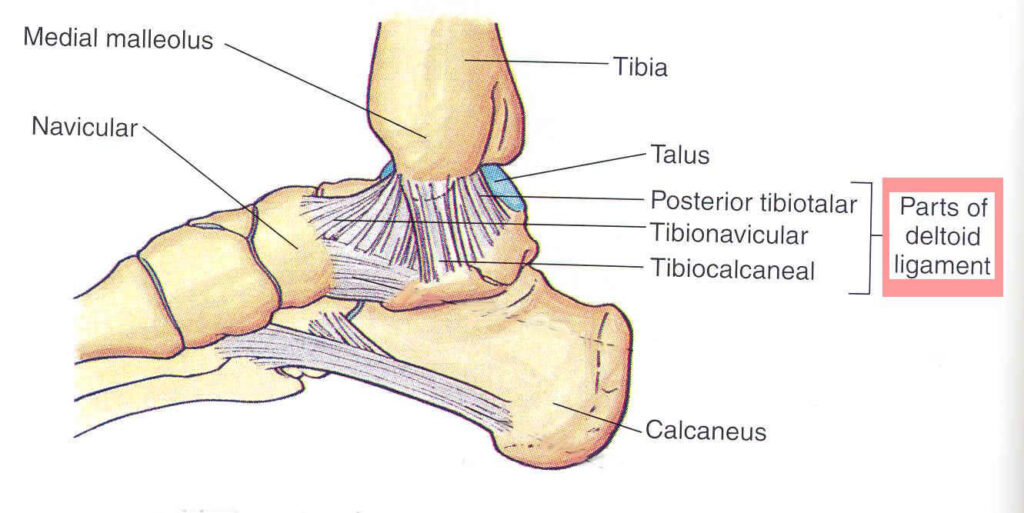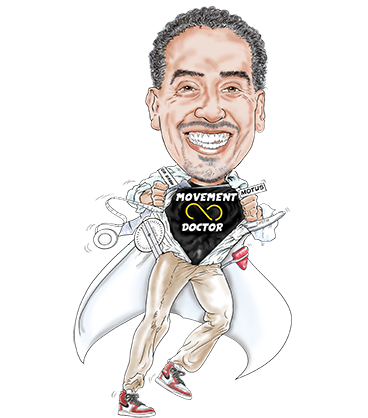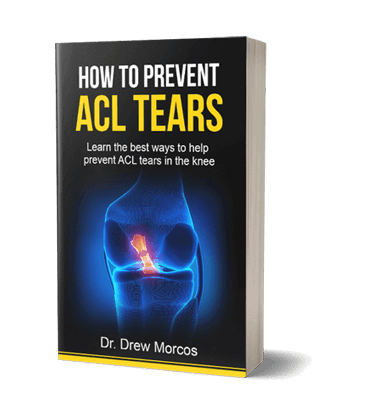Medial Ankle Sprain
Medial Ankle Sprain
If you have ever suffered from a medial ankle sprain, then you know how painful and debilitating it can be. This guide will provide you with everything you need to know about medial ankle sprains, from treatment options to rehabilitation exercises. So, whether you are a victim of this injury yourself or are looking to help someone who is, read on for information that can help.

What is a medial ankle sprain?
A medial ankle sprain is an injury to the ligaments on the inside of your ankle. These ankle ligaments provide stability to your ankle joint and help keep your foot from moving too far inward.
A medial ankle sprain can range from a mild injury, with only a few stretched or torn ligament fibers, to a severe injury, with a complete tear of the deltoid ligament.
Most medial ankle sprains occur when your foot rolls inward (inversion), causing the ligaments on the inside of your ankle to stretch or tear.
This type of injury can happen when you land on an uneven surface, such as a curb, or when you make a quick change in direction while participating in a sport.
Medial ankle sprains can be painful and may cause swelling, bruising, and difficulty walking. Severe injuries may also result in a feeling of instability in the ankle joint.

Symptoms of Medial Ankle Sprain
Medial ankle sprains are the most common type of ankle sprain, accounting for about 50% of all ankle sprains.
The most common symptom of a medial ankle sprain is pain on the inside of the ankle. Other symptoms may include:
– Tenderness on the inside of the ankle
– Swelling on the inside of the ankle
– Bruising on the inside of the ankle
– Difficulty walking or putting weight on the affected ankle
If you suspect that you have a medial ankle sprain, it is important to see a doctor or other medical professional for an evaluation.
Treatment for a medial ankle sprain typically includes rest, ice, and elevation of the affected ankle. In some cases, physical therapy may also be recommended. Surgery is rarely necessary.
Medial Ankle Sprain: Diagnosis
The physician will likely perform a physical examination to look for signs of injury. This may include palpating (feeling) the area for tenderness and swelling.
The physician may also test your range of motion and look for signs of instability.
Imaging studies, such as X-rays or MRIs, are generally not necessary to diagnose a medial ankle sprain. However, these studies may be ordered if the physician suspects a more serious injury, such as a fracture.

Treatment
The treatment of a medial ankle sprain is aimed at reducing pain and swelling and restoring range of motion and function.
Rest, ice, compression, and elevation (RICE) is often recommended for the first 24-48 hours after injury. This can help to reduce pain and swelling.
Nonsteroidal anti-inflammatory drugs (NSAIDs), such as ibuprofen, can also be helpful in reducing pain and inflammation. Be sure to follow the directions on the package insert and talk to your physician before taking any medication.
Once the acute pain and swelling have subsided, physical therapy may be recommended to help restore range of motion and strength. A home exercise program may also be recommended.
If you have a more severe medial ankle sprain, such as a high-grade sprain or a fracture, surgery may be necessary. Your physician will discuss the risks and benefits of surgery with you if this is the case.

Recovery
The recovery from a medial ankle sprain can vary depending on the severity of the injury. Most people with a mild sprain will recover within a few weeks.
However, it may take longer for those with a more severe injury to heal.
If you have a medial ankle sprain, it is important to follow your physician’s instructions for treatment and physical therapy.
Additionally, you should avoid activities that put undue stress on the ankle, such as running or jumping, until fully healed. If you have any questions or concerns, be sure to talk to your physician.
Long-term effects of a medial ankle sprain
Ankle sprains are one of the most common types of injuries, with over 25,000 people per day in the United States sustaining this type of injury. Medial ankle sprains account for approximately 40% of all ankle sprains.
While most medial ankle sprains will heal within a few weeks with little to no long-term effects, some individuals may experience chronic pain and instability in the affected ankle.
There are several things that can be done to prevent or minimize the long-term effects of a medial ankle sprain. First, it is important to seek medical attention as soon as possible after sustaining the injury.
This will ensure that the ankle is properly treated and that any underlying issues are addressed. Second, it is important to follow the recommended rehabilitation protocol. This may include physical therapy, exercises, and/or bracing. Third, individuals should avoid re-injuring the ankle by wearing proper footwear and using caution when participating in activities.
If you have sustained a medial ankle sprain and are experiencing chronic pain or instability, it is important to consult with a medical professional. There are several treatment options available that can help you minimize the long-term effects of this type of injury.

Exercises to improve Ankle Strength
1. Heel raises:
Slowly raise your heels off the ground while keeping your toes pointed forward. Hold this position for a few seconds before lowering your heels back down to the ground. Repeat this exercise 10-15 times.
2. Toe point and flex:
Point your toes forward as far as you can and then flex them back towards your shin. Hold each position for a few seconds. Repeat this exercise 10-15 times.
3. Ankle circles:
Move your ankle in a circle, both clockwise and counterclockwise. Repeat this exercise 10-15 times in each direction.
4. Side-to-side leg swings:
Swing your leg out to the side and then back across your body to the other side. Repeat this exercise 10-15 times on each side.
5. Heel walks:
Walk on your heels for a short distance and then reverse and walk on your toes for a short distance. Repeat this exercise several times.
6. Resistance band exercises:
There are a variety of resistance band exercises that can help to strengthen the muscles and ligaments around the ankle joint. Speak with your doctor or physical therapist about which exercises would be best for you to do.
7. Balance exercises:
Exercises that challenge your balance can also help to improve strength and stability in the ankle joint. Try standing on one leg for 30 seconds at a time or walking heel-to-toe in a straight line.
8. Stretches:
Be sure to stretch the muscles and ligaments around the ankle joint on a regular basis. A few good stretches include pointing and flexing the foot, calf raises, and ankle rotations.
Perform these exercises 2-3 times per day and you should see a noticeable improvement in strength and mobility in your ankle. However, if you experience any pain or discomfort while doing these exercises, stop immediately and consult your doctor.

Tips to prevent Ankle Injuries
Exercises that challenge your balance can also help to improve strength and stability in the ankle joint. Try standing on one leg for 30 seconds at a time or walking heel-to-toe in a straight line.
- Strengthen your ankle muscles by doing exercises that target the area, such as calf raises and ankle rotations.
- Wear supportive shoes that fit well and provide good arch support.
- Avoid high-impact activities if you have weak ankles or are prone to ankle injuries.
- Use proper form when participating in any physical activity to help reduce your risk of sustaining an ankle injury.
- Warm up before exercising or playing sports, and cool down afterward to help prevent strain on your ankles.
- If you do sustain an ankle injury, rest it as much as possible and ice it for 20 minutes at a time several times a day to reduce swelling.
Frequently Asked Questions
There are a few reasons why medial ankle sprains (ais) are relatively rare compared to other types of ankle injuries. First, the bones on the inside of the ankle (the tibia and fibula) are relatively close together, which provides extra stability to the joint. Second, the muscles and ligaments that support the joint (including the medial ankle ligament, deep deltoid ligament, or MCL) are particularly strong and well-developed.
Finally, the majority of people have a dominant “push-off” foot, which is usually the right foot for right-handed individuals. This means that when landing from a jump or other movement, the right ankle takes the brunt of the impact, while the left ankle is relatively protected. For all of these reasons, deltoid ligament injuries are much less common than other types of ankle injuries.
If you do happen to suffer a medial ankle sprain, it is important to seek medical attention as soon as possible. While most medial ankle sprains will heal on their own with time and rest, some may require surgery or other more aggressive treatment. An experienced orthopedic surgeon can determine the best course of action for your particular injury.
A sprained inner ankle usually feels like a sharp, shooting pain in the ankle. The pain is often worse when bearing weight on the affected foot or when walking. There may also be swelling and bruising around the ankle joint. In some cases, the ankle may feel unstable or “give way” when trying to bear weight. This can make it difficult to walk or stand on the affected foot.
If you have a sprained inner ankle, it is important to rest the joint and avoid putting weight on it. You should also ice the area for 15-20 minutes at a time, several times a day. This will help reduce swelling and pain. It is also important to wrap the ankle in an ACE bandage or similar support to help stabilize the joint. If the pain is severe or if you are having difficulty walking, it is important to see a doctor or orthopedic specialist for further treatment.
The most important thing you can do to treat a medial ankle or deltoid ligament sprain is to rest and ice the area. You should also avoid putting any weight on the ankle. If you need to, you can use crutches to help keep your weight off of the sprained ankle. You can also take over-the-counter pain medication to help with the pain and swelling. If the medial ankle pain and swelling are severe, you may need to see a doctor for further treatment. In some cases, surgery may be necessary to correct the problem.
The most common structures injured in a medial ankle sprain are the ligaments on the inside of the ankle near medial malleolus. These medial ligaments include the anterior talofibular ligament (ATFL), the calcaneofibular ligament (CFL), and the posterior talofibular ligament (PTFL). The ATFL is the most commonly injured ligament, followed by the CFL. The PTFL is the least common deltoid ligament injury.
Lateral ankle sprains are one of the most common injuries seen by doctors. They often occur during sports or other activities that involve sudden twisting or turning movements of the foot. The injury can range from a mild lateral ankle sprain to a complete tear of the lateral ankle ligaments. Severe sprains may also involve damage to other structures in the ankle, such as the bones or tendons.
Most lateral ankle sprains will heal with time and conservative treatment, but some may require surgery to repair the damaged ligaments. In severe cases, the ankle may be unstable and require long-term bracing or other support.
Have you been injured at some point in your journey?
Are you not achieving your highest level of function?
We’ve helped hundreds of people at all walks in life
get back to performing their best painfree!
3 Ways to Level Up Your Rehab and Injury Prevention With Us





